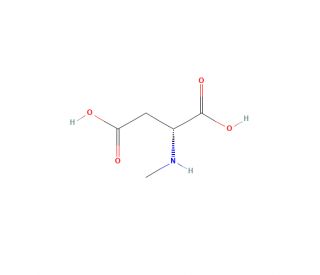

N-Methyl-D-Aspartic acid (NMDA) (CAS 6384-92-5)
See product citations (2)
QUICK LINKS
N-Methyl-D-Aspartic acid (NMDA) is a excitatory amino acid neurotransmitter predominantly present in the central nervous system (CNS). As a vital component of the glutamate-mediated excitatory neurotransmitter system, it plays a key role in facilitating long-term potentiation, an essential process for learning and memory formation. Its influence extends to various physiological processes encompassing neuroplasticity, neuronal development, and neuroprotection. N-Methyl-D-Aspartic acid (NMDA) acts through ligand-gated ion channels known as NMDA receptors, which are activated upon binding with N-Methyl-D-Aspartic acid (NMDA). Activation of these receptors allows the influx of calcium ions into the cell, leading to diverse physiological responses like neuronal excitation, synaptic plasticity, and long-term potentiation. N-Methyl-D-Aspartic acid (NMDA)′s impact spans several biochemical and physiological aspects, encompassing the regulation of neuronal excitability, synaptic plasticity, and long-term potentiation. It has also demonstrated involvement in neuronal development, synaptic plasticity, and long-term potentiation regulation. Furthermore, N-Methyl-D-Aspartic acid (NMDA) has exhibited various physiological effects such as anxiolytic, antidepressant, and anticonvulsant properties. N-Methyl-D-Aspartic acid (NMDA) itself can act as a synthetic agonist of the NMDA receptor, mimicking the binding action of the endogenous ligand glutamate. This receptor, a voltage-gated ion channel, is intricately involved in memory, spatial learning, and perturbing its normal behavior through N-Methyl-D-Aspartic acid (NMDA) exposure has aided in understanding NMDA receptor-mediated activities.
N-Methyl-D-Aspartic acid (NMDA) (CAS 6384-92-5) References
- Stimulation of NMDA and AMPA receptors in the rat nucleus basalis of Meynert affects sleep. | Manfridi, A., et al. 1999. Am J Physiol. 277: R1488-92. PMID: 10564223
- Occurrence of D-aspartic acid and N-methyl-D-aspartic acid in rat neuroendocrine tissues and their role in the modulation of luteinizing hormone and growth hormone release. | D'Aniello, A., et al. 2000. FASEB J. 14: 699-714. PMID: 10744627
- The role of D-aspartic acid and N-methyl-D-aspartic acid in the regulation of prolactin release. | D'Aniello, G., et al. 2000. Endocrinology. 141: 3862-70. PMID: 11014243
- N-methyl-D-aspartic acid receptor expression in the dorsolateral prefrontal cortex of elderly patients with schizophrenia. | Dracheva, S., et al. 2001. Am J Psychiatry. 158: 1400-10. PMID: 11532724
- Thyroid hormone regulation of N-methyl-D-aspartic acid receptor subunit mRNA expression in adult brain. | Lee, PR., et al. 2003. J Neuroendocrinol. 15: 87-92. PMID: 12535174
- Organization of single components of defensive behaviors within distinct columns of periaqueductal gray matter of the rat: role of N-methyl-D-aspartic acid glutamate receptors. | Bittencourt, AS., et al. 2004. Neuroscience. 125: 71-89. PMID: 15051147
- Model of infantile spasms induced by N-methyl-D-aspartic acid in prenatally impaired brain. | Velísek, L., et al. 2007. Ann Neurol. 61: 109-19. PMID: 17315208
- The induction and maintenance of central sensitization is dependent on N-methyl-D-aspartic acid receptor activation; implications for the treatment of post-injury pain hypersensitivity states. | Woolf, CJ. and Thompson, SWN. 1991. Pain. 44: 293-299. PMID: 1828878
- Structural, conformational, and stereochemical requirements of central excitatory amino acid receptors. | Hansen, JJ. and Krogsgaard-Larsen, P. 1990. Med Res Rev. 10: 55-94. PMID: 2153264
- Permeation and block of N-methyl-D-aspartic acid receptor channels by divalent cations in mouse cultured central neurones. | Mayer, ML. and Westbrook, GL. 1987. J Physiol. 394: 501-27. PMID: 2451020
- A glycine site associated with N-methyl-D-aspartic acid receptors: characterization and identification of a new class of antagonists. | Kessler, M., et al. 1989. J Neurochem. 52: 1319-28. PMID: 2538568
- The action of N-methyl-D-aspartic acid on mouse spinal neurones in culture. | Mayer, ML. and Westbrook, GL. 1985. J Physiol. 361: 65-90. PMID: 2580984
- N-methyl-D-aspartic acid-induced lethality in mice: selective antagonism by phencyclidine-like drugs. | Leander, JD., et al. 1988. Brain Res. 448: 115-20. PMID: 3292008
- Excitatory amino acid transmitters. | Watkins, JC. and Evans, RH. 1981. Annu Rev Pharmacol Toxicol. 21: 165-204. PMID: 6112965
- Testing the NMDA, long-term potentiation, and cholinergic hypotheses of spatial learning. | Cain, DP. 1998. Neurosci Biobehav Rev. 22: 181-93. PMID: 9579310
Ordering Information
| Product Name | Catalog # | UNIT | Price | Qty | FAVORITES | |
N-Methyl-D-Aspartic acid (NMDA), 50 mg | sc-200458 | 50 mg | $107.00 | |||
N-Methyl-D-Aspartic acid (NMDA), 250 mg | sc-200458A | 250 mg | $362.00 |
